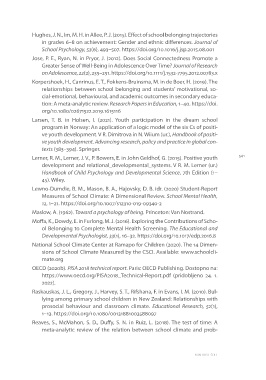Page 541 - Kozina, Ana, Tina Pivec, Ana Mlekuž, Urška Štremfel, Janja Žmavc, Katja Košir, Ajda Mlakar, Martina Zakšek. 2022. Pozitivni razvoj mladih v Sloveniji: razvojne poti v kontekstu migracij. Ljubljana: Pedagoški inštitut, 2022. Digitalna knjižnica, Documenta 22.
P. 541
hes, J. N., Im, M. H. in Allee, P. J. (2015). Effect of school belonging trajectories 541
in grades 6–8 on achievement: Gender and ethnic differences. Journal of
School Psychology, 53(6), 493–507. https://doi.org/10.1016/j.jsp.2015.08.001
Jose, P. E., Ryan, N. in Pryor, J. (2012). Does Social Connectedness Promote a
Greater Sense of Well-Being in Adolescence Over Time? Journal of Research
on Adolescence, 22(2), 235–251. https://doi.org/10.1111/j.1532-7795.2012.00783.x
Korpershoek, H., Canrinus, E. T., Fokkens-Bruinsma, M. in de Boer, H. (2019). The
relationships between school belonging and students’ motivational, so-
cial-emotional, behavioural, and academic outcomes in secondary educa-
tion: A meta-analytic review. Research Papers in Education, 1–40. https://doi.
org/10.1080/02671522.2019.1615116
Larsen, T. B. in Holsen, I. (2021). Youth participation in the dream school
program in Norway: An application of a logic model of the six Cs of positi-
ve youth development. V R. Dimitrova in N. Wiium (ur.), Handbook of positi
ve youth development. Advancing research, policy and practice in global con
texts (383–394). Springer.
Lerner, R. M., Lerner, J. V., P. Bowers, E. in John Geldhof, G. (2015). Positive youth
development and relational_developmental_systems. V R. M. Lerner (ur.)
Handbook of Child Psychology and Developmental Science, 7th Edition (1–
45). Wiley.
Lewno-Dumdie, B. M., Mason, B. A., Hajovsky, D. B. idr. (2020) Student-Report
Measures of School Climate: A Dimensional Review. School Mental Health,
12, 1–21. https://doi.org/10.1007/s12310-019-09340-2
Maslow, A. (1962). Toward a psychology of being. Princeton: Van Nostrand.
Moffa, K., Dowdy, E. in Furlong, M. J. (2016). Exploring the Contributions of Scho-
ol Belonging to Complete Mental Health Screening. The Educational and
Developmental Psychologist, 33(1), 16–32. https://doi.org/10.1017/edp.2016.8
National School Climate Center at Ramapo for Children (2020). The 14 Dimen-
sions of School Climate Measured by the CSCI. Available: www.schoolcli-
mate.org
OECD (2020b). PISA 2018 technical report. Paris: OECD Publishing. Dostopno na:
https://www.oecd.org/PISA2018_Technical-Report.pdf (pridobljeno 24. 1.
2022).
Raskauskas, J. L., Gregory, J., Harvey, S. T., Rifshana, F. in Evans, I. M. (2010). Bul-
lying among primary school children in New Zealand: Relationships with
prosocial behaviour and classroom climate. Educational Research, 52(1),
1–13. https://doi.org/10.1080/00131881003588097
Reaves, S., McMahon, S. D., Duffy, S. N. in Ruiz, L. (2018). The test of time: A
meta-analytic review of the relation between school climate and prob-
kontekst šole
in grades 6–8 on achievement: Gender and ethnic differences. Journal of
School Psychology, 53(6), 493–507. https://doi.org/10.1016/j.jsp.2015.08.001
Jose, P. E., Ryan, N. in Pryor, J. (2012). Does Social Connectedness Promote a
Greater Sense of Well-Being in Adolescence Over Time? Journal of Research
on Adolescence, 22(2), 235–251. https://doi.org/10.1111/j.1532-7795.2012.00783.x
Korpershoek, H., Canrinus, E. T., Fokkens-Bruinsma, M. in de Boer, H. (2019). The
relationships between school belonging and students’ motivational, so-
cial-emotional, behavioural, and academic outcomes in secondary educa-
tion: A meta-analytic review. Research Papers in Education, 1–40. https://doi.
org/10.1080/02671522.2019.1615116
Larsen, T. B. in Holsen, I. (2021). Youth participation in the dream school
program in Norway: An application of a logic model of the six Cs of positi-
ve youth development. V R. Dimitrova in N. Wiium (ur.), Handbook of positi
ve youth development. Advancing research, policy and practice in global con
texts (383–394). Springer.
Lerner, R. M., Lerner, J. V., P. Bowers, E. in John Geldhof, G. (2015). Positive youth
development and relational_developmental_systems. V R. M. Lerner (ur.)
Handbook of Child Psychology and Developmental Science, 7th Edition (1–
45). Wiley.
Lewno-Dumdie, B. M., Mason, B. A., Hajovsky, D. B. idr. (2020) Student-Report
Measures of School Climate: A Dimensional Review. School Mental Health,
12, 1–21. https://doi.org/10.1007/s12310-019-09340-2
Maslow, A. (1962). Toward a psychology of being. Princeton: Van Nostrand.
Moffa, K., Dowdy, E. in Furlong, M. J. (2016). Exploring the Contributions of Scho-
ol Belonging to Complete Mental Health Screening. The Educational and
Developmental Psychologist, 33(1), 16–32. https://doi.org/10.1017/edp.2016.8
National School Climate Center at Ramapo for Children (2020). The 14 Dimen-
sions of School Climate Measured by the CSCI. Available: www.schoolcli-
mate.org
OECD (2020b). PISA 2018 technical report. Paris: OECD Publishing. Dostopno na:
https://www.oecd.org/PISA2018_Technical-Report.pdf (pridobljeno 24. 1.
2022).
Raskauskas, J. L., Gregory, J., Harvey, S. T., Rifshana, F. in Evans, I. M. (2010). Bul-
lying among primary school children in New Zealand: Relationships with
prosocial behaviour and classroom climate. Educational Research, 52(1),
1–13. https://doi.org/10.1080/00131881003588097
Reaves, S., McMahon, S. D., Duffy, S. N. in Ruiz, L. (2018). The test of time: A
meta-analytic review of the relation between school climate and prob-
kontekst šole


